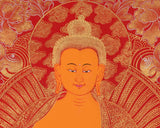









Buddha Shakyamuni Thangka | Religious Buddhist Painting | Wall Decors

100% AUTHENTIC

HANDPAINTED

FREE SHIPPING
Shakyamuni Buddha Thangka
Introduction To The Thangka :
Shakyamuni Buddha is the historical Buddha and the creator of Buddhist theology. Each "Kalpa" (Buddhist eon) is supposed to have its own Buddha, whose teachings dwindle until the next Buddha arrives. He lived around 420 BC and spent most of his time promoting Dharma teachings. The Life of Buddha Thangka depicts his life in great detail. He is regarded as a role model, mentor, and source of inspiration. His survival on Earth is seen to be ensured by "dharma," or spiritual belief, and "sanga," or Buddhist community.
How to take care of your thangka?
-Hang your thangka in a traditional silk brocade
-Regular Inspection of your thangka; examine the borders and all attachments.
-Keep thangkas covered when they are on display but not in use.
-Rotate thangkas between display and storage on a regular basis, two to four times a year, to reduce the amount of exposure to light. Keep away from sunlight and humidity.
-Do not apply liquids or other materials to the surface of the thangka.
------------------------------------------------------------------
Size: 20"/ 51 cm (width) x 30"/ 76 cm (height)
Materials: Cotton Canvas, Acrylic Colors, Genuine 24K Gold
------------------------------------------------------------------
THIS THANGKA IS HAND-PAINTED IN THE TRADITIONAL STYLE BY NEPALI ARTIST AND THE QUALITY IS HIGH
------------------------------------------------------------------
How does Thangka benefit us?
It goes without saying that every detail of a painting has a symbolic meaning. Regardless of your religious affiliation, a thangka can help you on your path to enlightenment, whether you practice Buddhism or have other religious convictions. Thangkas are paintings that depict deities with various iconographic elements and symbolism that encourage meditation on the teachings of the god they depict. Any thangka is intended to aid in the removal of the film of ignorance, which is a significant barrier to the road to enlightenment. The Thangka is revered as a holy item. They promote positivity, spread Buddhism's teachings, bring about peace, harmony, and oneness, and dispel any negative energy that may be there.
How to Take Care of Your Thangka?
- Hang your thangka in a traditional silk brocade.
- Regularly inspect your thangka; examine the borders and all attachments.
- Keep thangkas covered when they are on display but not in use.
- Rotate thangkas between display and storage two to four times a year to reduce exposure to light. Keep them away from sunlight and humidity.
- Do not apply liquids or other materials to the surface of the thangka.




















